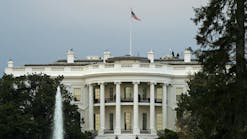White House eyes steps to curb methane emissions from oil, gas operations
The White House announced additional steps to reduce methane emissions from oil and natural gas operations as part of a broader strategy. They included regulations to be proposed later this year by the US Bureau of Land Management to curb gas flaring on public lands.
The moves will build on successes achieved through voluntary efforts and targeted regulations, according to Dan Utech, special assistant to US President Barack Obama for energy and climate change.
The US Environmental Protection Agency will assess "several potentially significant sources of methane and other emissions from the oil and gas sector" this spring, Utech said in a blog at the White House web site.
"EPA will solicit input from independent experts through a series of technical white papers, and in the fall of 2014, EPA will determine how best to pursue further methane reductions from these sources," Utech indicated. If EPA decides to formulate additional regulations, it would complete them by yearend 2016, he said.
The administration will also identify downstream methane reduction opportunities as part of its Quadrennial Energy Review and through roundtables convened by the US Department of Energy, he added.
Oil and gas activities represented 28% of the total 2012 domestic methane emissions, the strategy said. The equivalent of 127 million tons of carbon dioxide was emitted as methane from production, processing, transmission, storage, and distribution gas, it noted. Methane emissions from crude oil production and refining were the equivalent of 32 million tons of CO2, it said.
‘Build on progress'
The strategy said that within the gas industry, 31% of this methane came from production sources, 15% from processing, 34% from transmission and storage, and 20% from distribution. "As our use of gas in manufacturing, transportation, and power generation increases—creating jobs, reducing costs, cutting carbon pollution, and reducing dependence on foreign oil—we must continue to build on progress in reducing methane emissions from this vital sector of our economy," the strategy said.
It recognized that states are "primary regulators of many aspects of oil and gas production activities and the distribution of natural gas" and said DOE and EPA would continue to provide technical assistant to support effective state emissions reduction actions and to encourage broader adoption of proven mitigation strategies.
When it came to "building on commonsense standards," the strategy noted that EPA issued final regulations on Apr. 12, 2012, to volatile organic compounds (VOCs) emissions, "establishing, among other things, the first federal air pollution standards for gas wells that are hydraulically fractured, along with requirements for other sources, such as compressors, that were not previously regulated at the federal level."
While the rules targeted VOCs, they also reduced methane emissions substantially, the strategy said. EPA estimates when they are fully implemented in 2015, the 2012 rules will decrease methane emissions to 33 million tons/year of CO2, it added.
It said the technical papers EPA will release this spring will focus on emissions control technologies targeting both VOCs and methane, with particular focus on oil and coproducing wells, liquids unloading, leaks, pneumatic devices, and compressors.
"The agency will use these technical documents to solidify its understanding of these potentially significant sources of methane," the strategy said. "This robust technical understanding will allow the agency to fully evaluate the range of policy mechanisms that will cost-effectively cut methane waste and emissions."
Working with stakeholders
The administration also plans to work with key stakeholders to reduce methane emissions from gas activities. US Sec. of Energy Ernest G. Moniz hosted a Mar. 19 roundtable with industry, state governments, academia, nongovernmental organizations, and labor leaders, the strategy said.
"DOE will sponsor additional roundtable discussions with stakeholders, with the primary objective of accelerating the adoption of best practices for reducing methane emissions from gas systems," it added.
Through these roundtables, the administration also hopes to promote a common understanding of natural gas systems' methane emissions and related abatement opportunities; develop cost-effective strategies to reduce methane emissions from processing, transmission, and storage and distribution operations; "catalyze greater action and engagement by policymakers at all levels of government"; and encourage the gas industry to participate more fully in existing voluntary programs.
Industry groups responded immediately. "The industry has led efforts to reduce emissions of methane by developing new technologies and equipment, and recent studies show emissions are far lower than EPA projected just a few years ago," said Howard Feldman, the American Petroleum Institute's regulatory and scientific affairs director.
"Additional regulations are not necessary and could have a chilling effect on the American energy renaissance, our economy, and our national security," he warned.
‘Misdirected plan'
"Generally, I find the president's plan on methane to be misdirected," said Kathleen Sgamma, vice-president of government and public affairs at the Western Energy Alliance in Denver. "In his general climate action plan, he failed to acknowledge the true reason America's greenhouse gas emissions have gone down more than any other industrialized nations—its increased use of natural gas.
"Now, he's trying to regulate methane when the oil and gas industry has already delivered a success story," she told OGJ by phone. "Since 2006, we have reduced methane emissions by 40% even as gas production is up 26%, according to EPA's recently release greenhouse gas emissions inventory. So we're already reducing methane emissions significantly.
"Regulations that make gas production more expensive will just be counter to the president's own climate change goals," Sgamma said. "Less gas use means fewer GHG reductions."
Others took a positive approach. "We are pleased the administration has embraced natural gas because it is domestic, abundant, affordable and clean-burning," Interstate Natural Gas Association of America Pres. Donald F. Santa said.
"It also has been one of the few bright spots in the nation's economy in recent years by helping to revive the US manufacturing industry and putting disposable income in the pockets of Americans as a result of lower energy prices," he continued. "Reducing releases will only cement gas's future as a central part of America's energy policy."
Meanwhile, America's Natural Gas Alliance Pres. Martin J. Durbin said, "The White House clearly acknowledges the substantial gains our industry has made through voluntary efforts and recognizes that states should continue to play a leading role in helping to achieve further reductions going forward. We appreciate that the administration has initiated a collaborative process and we look forward to being part of the solution to addressing methane emissions."
Cites common goal
"We all share the goal of a safe, resilient, clean energy infrastructure and natural gas utilities are working with state regulators and key stakeholders to do our part," said American Gas Association Pres. Dave McCurdy. "Smart, cost-effective investments in system modernization can continue, and accelerate, the trend in decreasing gas emissions."
Other federal and state officials responded. US Sec. of the Interior Sally Jewell confirmed that BLM is studying ways to reduce the amount of methane flared not only from oil and gas development on public land, but also as waste from coal mines. "We will continue to work hand in hand with states and industry to power more homes with cleaner American-made energy, while reducing methane emissions and cutting carbon pollution," she said.
Colette D. Honorable, president of the National Association of Regulatory Commissioners and chairwoman of the Arkansas Public Service Commission, stated, "We appreciate the White House's acknowledgement of the ongoing efforts at the state level to improve the safe and efficient operation of our nation's pipeline infrastructure. For NARUC members, safety is and remains Job No. 1, and as this report demonstrates, states have been true leaders."
Environmental organizations' reactions to the White House's plan were mixed. "This strategy has the potential to deliver the federal regulatory oversight that is needed to complement state efforts and make sure that all of the oil and gas industry meets basic, commonsense standards to deploy readily available technologies," Environmental Defense Fund Pres. Fred Krupp said. "The most important work of turning this strategy into action lies ahead, but we are confident that the case for action is strong and will prove out in the end."
Meanwhile, Earthworks Policy Director Lauren Pagel said, "We applaud the White House for taking a first step to curb methane emissions, a climate pollutant that is 84 times more potent than carbon dioxide. But, no matter how stringent the methane pollution controls, they are no substitute for dropping dirty fossil fuels like fraced gas and replacing them with truly clean alternatives like conservation and renewables."
She said, "The president can't have it both ways. He can fight climate change, or he can promote fracing and unconventional oil and gas production. He can't do both."

Nick Snow
NICK SNOW covered oil and gas in Washington for more than 30 years. He worked in several capacities for The Oil Daily and was founding editor of Petroleum Finance Week before joining OGJ as its Washington correspondent in September 2005 and becoming its full-time Washington editor in October 2007. He retired from OGJ in January 2020.


